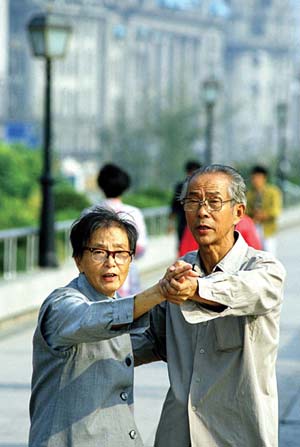| The Silver Tide Comes In |
| http://www.sina.com.cn 2005/02/03 14:52 thats China |
 Dancing exercise in the early morning China's rapidly aging population: A burden or a resource? By Bo Schwerin They emerge before dawn, but vanish by the start of morning rush hour. They reappear in the evenings after the city's workforce has retired to their homes. They bear swords, fans and musical instruments into the city's parks and public spaces, moving with the practiced smoothness of tajiquan masters and ballroom dancers, exercising with the discipline of gong fu pupils. Although they compose 14 percent of the city's population, most nine-to-five workers rarely encounter them in the street. They are the senior citizens of Beijing. You might think China is looking to its younger generations to secure a prosperous future, but that future may very well hinge on the elderly (laoren) of Beijing and the rest of the country. Out of a nationwide population of 1.3 billion, more than 10 percent of Chinese people are now over the age of 60. This number will reach 14 percent, or 200 million people, by 2015. By 2050, nearly a quarter of China's populace - 400 million people - will have reached 60 years of age, a larger number than the total populations of present-day Japan, France, Italy, Germany, and the United States combined. These are numbers that have attracted the attention of the Chinese government and China-watchers around the globe. It has only taken the country 20 years to mature from an "adult" to an "aged" society (the United Nations defines "aged" as 7 percent over 65 or 10 percent over 60). Only Japan has aged faster, reaching the UN benchmark in the '70s. Other countries, such as the United States and France, won't reach that mark for another 60 and 100 years respectively. The extraordinary quickness with which China has accumulated a massive elderly population has sent up warning flags about the impact upon the country's much ballyhooed re-emergence as a world power. Much of the buzz has a distinctly worried tone, but some - most importantly the elderly themselves - are quick to point out that China's senior citizens could prove an indispensable resource rather than an exhausting burden. Causes and consequences Falling fertility rates and lengthening life spans combine to produce a population age structure increasingly skewed toward the older age brackets. These factors typically come hand in hand with developed nation status; as living conditions and health care continually improve, citizens live longer and have less need for children, which in many developing countries are often desired by families as a source of labor and future support. More available birth control methods are another cause of declining birth rates. What makes China's situation unique, says Sun Pengbiao, deputy director of the Shanghai Research Center on Aging, is that "China became an aging country while it was still a developing country." While China has the economy of a developing nation, it has the reversed age pyramid of a long-developed one. The launch of this trend may be linked to China's best-known population problem: Overpopulation. In 1979, the Chinese government enforced the "one child" population control policy, nominally limiting, with a number of exceptions, the number of offspring a couple could have to a single child. The 1.3 billionth baby was born in China on January 6 this year, an event that would have happened four years earlier had China allowed its population to grow unchecked.
|
|
|
|
|
|
| Annotation |
| 新 闻 查 询 |
| 热 点 专 题 | ||||
| ||||
|
教育频道意见反馈留言板 电话:010-82628888-5747 欢迎批评指正
新浪简介 | About Sina | 广告服务 | 联系我们 | 招聘信息 | 网站律师 | SINA English | 会员注册 | 产品答疑
Copyright © 1996 - 2005 SINA Inc. All Rights Reserved
版权所有 新浪网![]() 北京市通信公司提供网络带宽
北京市通信公司提供网络带宽